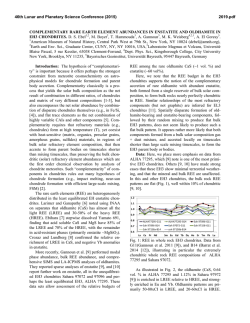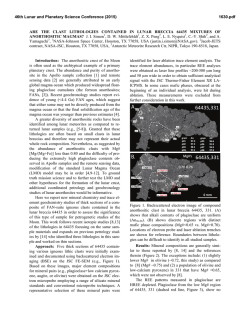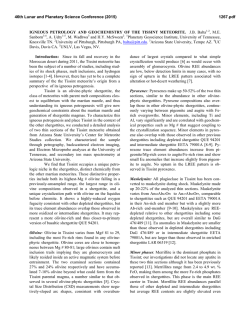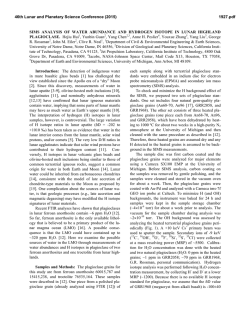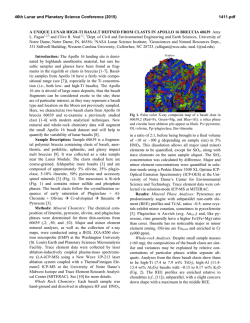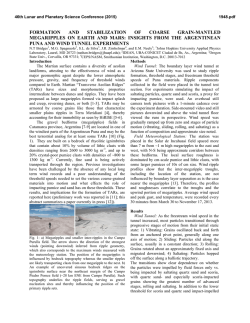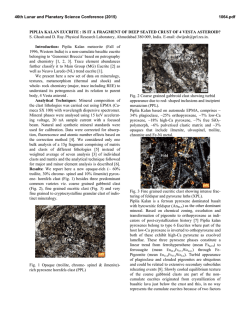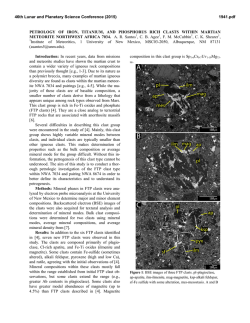
DO REE AND Ti IN LUNAR ZIRCONS REFLECT TEMPERATURE
46th Lunar and Planetary Science Conference (2015) 1910.pdf DO REE AND Ti IN LUNAR ZIRCONS REFLECT TEMPERATURE AND OXYGEN FUGACITY OF LUNAR MAGMAS? M. G. Grange1, A. A. Nemchin1,2, M. J. Whitehouse2 and R. E. Merle1, 1Department of Applied Geology, Curtin University, Perth, Australia ([email protected]), 2Swedish Museum of Natural History, Stockholm, Sweden. Introduction: Rare Earth Elements (REE) in zircon are often used to obtain information about the environment that existed during crystallization of their parent rocks [e.g. 1, 2]. They have proved especially useful to track ancient environments of crystallization such as those that prevailed during Hadean times, for which rock record is not available [3]. In particular LREE enrichment observed in some >4.0 Ga zircon from Jack Hills (Western Australia) were interpreted as either reflecting their origin in granite magma or a signature of hydrothermal alteration [1, 3], while positive Ce-anomalies exhibited by these grains are taken as evidence of oxidizing conditions developed on the Earth at the time of zircon formation [4]. However, use of zircon for this purpose has also triggered controversy as some studies have shown that incorporation of REE within the zircon lattice depends on several factors in addition to the changes to the environment during zircon crystallization [5] and linking REE in zircon to the composition of their host rocks by simply applying partition coefficients may lead to spurious results [5, 6]. Despite these reservations, REE concentrations in zircon continue to be used as petrogenetic indicators. Lunar plutonic rocks have not been altered by hydrothermal processes or regional metamorphism and do not show the wide complexity of their terrestrial counterparts. Therefore investigation of REE in lunar zircon crystallized within KREEP-rich differentiated rocks (i.e. rocks from the Mg- and alkali-suite) may help to better understand the usefulness (or lack thereof) of REE in zircon as petrogenetic indicators. REE in lunar zircons found as mineral clasts within impact melt breccias have been investigated previously in attempt to constrain the compositions of their source rock, as completely preserved samples of lunar plutonic rocks are relatively rare in the Apollo collection [6]. Although this study suggested grouping of different zircon grains into four categories according to their REE patterns, it also showed that it was not possible to ascribe any of the groups to a single parent rock. Furthermore, it concluded that zircon likely crystallized from small pockets of melt where REE content strongly depends on crystallization of other mineral phases in the close vicinity of zircon and, therefore, REE in zircon do not reflect the parental rock chemistry [6]. Unlike our previous investigation [6], some of the zircons analyzed during this study were enclosed with- in lithic clasts and therefore mineral phases other than zircon were accessible to characterize the parent rock, using both qualitative and quantitative analyses (with SEM fitted EDS and electron microprobe respectively). This study presents additional REE and Ti-inzircon measurements obtained from lunar zircons from Apollo 14 and 17 samples. Analytical techniques: REE data were obtained using the CAMECA IMS1280 at the Nordsims lab in Stockholm following procedures described in [7]. Tiin-zircon analyses were done using SHRIMP housed by the John deLaeter centre at Curtin University following analytical protocol described in [8] and temperatures were calculated using the Ferry and Watson thermometer [9]. The amplitude of Ce anomaly in zircon (with respect to neighbouring REE La and Pr) is dependent on temperature and oxygen fugacity of the melt where the zircon crystallized. By using the calculated temperature of crystallization as obtained by Tiin-zircon and the REE data, it is possible to estimate the oxygen fugacity using the empirical equation determined by [4]. Results: Investigated zircon-enclosing lithic clasts can be classified as granite, gabbronorite, quartzmonzodiorite (QMD) and anorthosite. 50% of the zircons (7 out of 14) located in lithic clasts are found within granite, 3 are found in QMD, 3 in anorthosite and only 1 in gabbronorite. The rest of the studied grains (n=8) are mineral clasts in the breccia matrix. Figure 1: REE patterns of zircon within (a) granite, (b) gabbronorite, (c) QMD and (d) anorthosite clasts. REE patterns. Zircons within granite show a very large variation in their REE patterns, as do zircons 46th Lunar and Planetary Science Conference (2015) within anorthosite clasts. It has to be noted, however, that the number of analyses obtained on grains from granite and anorthosite clasts is also much larger than those obtained for grains from the other clasts types. There is no consistency in REE patterns within individual lithic clast and there are also significant variations in light REE concentrations even within individual zircon grains. Although there is a lot of inconsistency within zircon REE patterns, concentrations of REE and especially LREE are correlated with the content of U and Th. For grains with multiple analyses, LREE are more abundant in areas having also higher U and Th content. This indicates that REE were enriched together with U and Th as a result of differentiation of the melt with some of the observed extreme enrichment corresponding to the very last stages of crystallization. Figure 2: Total LREE vs. U (ppm) for zircon grains with multiple analyses (Apollo 14 and 17) Oxygen fugacities. Cerium can exist either as Ce3+ (as most other REE) or Ce4+. The occurrence of Ce4+ is enhanced by oxidized environment and Ce4+ is largely more compatible in zircon than Ce3+. The magnitude of the Ce (positive) anomaly in zircon depends on the Ce4+/Ce3+ of the melt from which it crystallizes and is more pronounced if this melt is oxidized, i.e. has high oxygen fugacity (fO2). Consequently, the Ce anomaly in zircon will reflect the fO2 of the melt where the zircon crystallized. Majority of calculated fO2 for melts which crystallized lunar zircon are relatively low and close to or below the iron-wüstite (IW) buffer. As such, they are comparable to what was calculated previously [4, 10] and indicate relatively reducing conditions associated with lunar magmas. However, the two data points with the lowest T (~800°C) correspond to zircon grains from sample 14321 and also have pronounced positive Ce anomalies. One of these grains indicates fO2 close to the FMQ buffer, suggesting that oxidizing conditions can also form during the magma fractionation on 1910.pdf the generally reduced Moon and that the presence of Ce-anomaly shown by the zircon REE pattern cannot necessarily be extrapolated into conclusions about oxidation state on an entire planetary body. Figure 3: Plot of oxygen fugacity (fO2) vs temperature as measured from Ti-in-zircon. Conclusions: A careful examination of REE concentrations, U-Pb data, Ti-in-zircon measurements and calculated fO2 in lunar zircons indicates that REE contents can vary significantly even within a single zircon grain and are not consistently correlated with the composition of the host rock, supporting previous conclusion [6] that they may reflect very localized (mm size) residual pockets of the melt where zircon is forming, rather than large scale magma chamber or even planetary phenomena. Significantly, the common LREE enrichment observed in lunar mafic rocks together with the absence of extensive hydrothermal processes on the Moon cast doubts on the validity of conclusions that similar features observed in the oldest terrestrial zircon point uniquely to their origin in granitic magma or alteration of these grains by hydrothermal fluids. Similarly, the Ce-anomaly in some zircons from the Moon, which is generally reduced, questions whether the observation of this anomaly in Jack Hills zircons can uniquely lead to the conclusion that Earth’s crust and mantle were oxidized in the Hadean. References: [1] Hoskin P.W.O. & Ireland T.R. (2000) Geology, 28, 627-630. [2] Hoskin P.W.O. & Schaltegger U. (2003) Rev. Mineral. Geochem., 53, 27-62. [3] Peck W.H. et al. (2001) GCA, 65, 4215– 4229. [4] Trail D. et al. (2011) Nature, 480, 79-83. [5] Whitehouse M.J. & Kamber B.S. (2002) EPSL, 204, 333-346. [6] Nemchin et al., 2010, Am. Mineral., 95, 273-283. [7] Whitehouse (2004) Geostand. Geoanal Res, 28, 195-201. [8] Grange M.L. et al. (2009) GCA, 73, 3093-3107. [9] Ferry J.M. & Watson E.B. (2007) Contrib. Mineral. Petrol., 154, 429-437. [10] Taylor D.J. et al. (2009) EPSL, 279, 157-164.
© Copyright 2025
